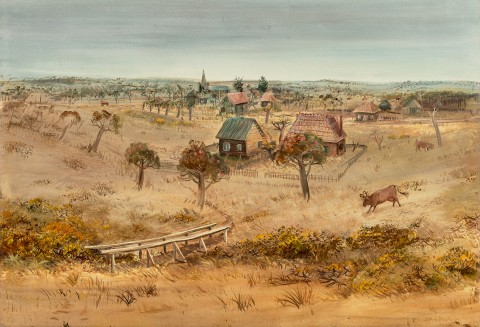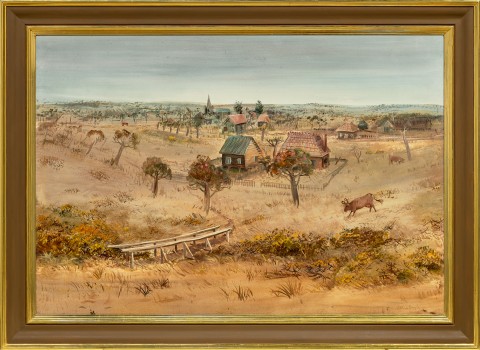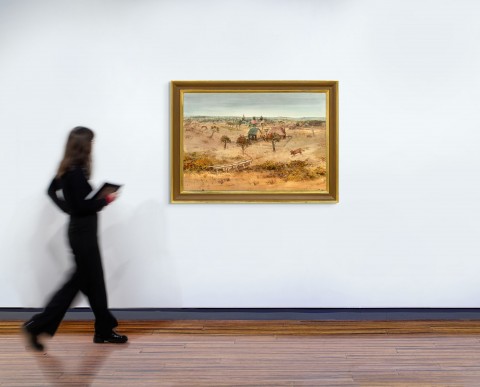(1920 - 1999)
Arthur Boyd
White bridge, c.1949 - 51
oil and tempera on composition board
Private collection
Leonard Joel, Melbourne, 16 April 1986, lot 61
Holmes à Court Collection, Perth
Chrisites, Melbourne, 29 April 1996, lot 34 (as ‘Early Murrumbeena’)
Private collection, Perth
Arthur Boyd, David Jones’ Art Gallery, Sydney, 4 – 16 September 1950, cat. 20
European and Australian Paintings from the Robert Holmes à Court Collection, S. H. Ervin, Museum and Art Gallery, Sydney, 28 April - 4 June 1988, cat. 35 (as ‘Early Murrumbeena, 1949 – 51’)
Arthur Boyd: Brides, Myths and Landscapes, Savill Galleries, Sydney, 23 March – 29 April 1995, cat. 1 (illus. in exhibition catalogue, as ‘Murrumbeena’)
Arthur Boyd’s White bridge, c.1949 – 50 is a recent rediscovery, a painting which was included in his solo exhibition at David Jones Art Gallery, Sydney, in September 1950. This was a large showing of forty-four paintings, a mini survey which charted Boyd’s progression from 1945, near the time that Albert Tucker first recommended Boyd read Max Doerner’s treatise The Materials of the Artists and Their Use in Painting (1934). Inspired by its contents, Boyd had undertaken an in-depth study of the techniques used by the Old Masters, the results of which ranged from populous Old Testament paintings from 1945, to shimmering, wheat-yellow visions of the Wimmera painted in 1950. For more than four decades, White bridge was mistitled Early Murrumbeena, alluding to the semi-rural suburb of Melbourne where Boyd had grown up at the overgrown family compound ‘Open Country’. However, this title does not appear in any of Boyd’s exhibition catalogues nor in Franz Phillip’s near-comprehensive catalogue raisonné compiled in 1967.1
It is more likely that the location is Bentleigh East, two kilometres south of Murrumbeena, with the single-spired church in the background nominally identified as the original St John’s Anglican Church, demolished in the early 1960s. At that time, Bentleigh East was a scatter of cottages set amidst market gardens and orchards, with a number of these holding single cows or sheep on their properties. White bridge thus captures a scene that would soon be obliterated by the post-war boom in suburban living when most of these allotments were sold and subdivided for housing. It is also an intriguing transitional work linking Boyd’s near-expressionist paintings from 1948 of the tangled scrub around Berwick to the newer paintings from the Wimmera. Using Doerner’s book as a guide, Boyd began his grand cycle of religious paintings, inspired in part by memories of his grandmother reading from her illustrated Bible, even though he later stated, ‘I can’t remember ever having a belief in God. I didn’t think it was necessary.’2 A number of these religious works were shown alongside White bridge at David Jones Art Gallery, including the now iconic The king (The deluge), 1944 (National Gallery of Australia) and The mockers, 1945 (Art Gallery of New South Wales). Doerner’s advice also led Boyd to experiment with the centuries-old technique of egg tempera, which ‘gave a new translucency to his paintings of the late 1940s,’3 including landscapes painted in nearby Moorabbin, Oakleigh and Bentleigh.
In the autumn of 1950, Betty Bennett, a friend of Boyd’s wife Yvonne, invited the family to stay at her house in Horsham. This was a catalyst moment for Boyd and an inspection of some of the resultant Wimmera paintings suggest that White bridge is closely related to this time. The sky, for example, is composed of horizonal bands of dilute glaze, each successive layer building on the pigments beneath to create coloured fields of great depth. This application was enhanced by Boyd’s increasing use of a Swedish-manufactured Masonite which had a smoother surface than others available in Melbourne at that time. He used the same technique for the skies of at least two of these paintings from 1950: Broken Falls, The Grampians, 1950 (National Gallery of Australia), and Cyanide tanks, Bendigo, c.1952 (Art Gallery of South Australia), both of which were also included in the David Jones show. The bridge of the title is in the foreground, comprised of creamy-white strokes applied with a fluid brush, its jauntiness at odds with the near-hidden creek that it traverses, a darkened gully that exudes a somewhat haunted air. The brown cow is a personal symbol whose curlicue horns link it to Boyd’s imaginary hybrid, the ‘Ramox’, which first appeared in paintings from 1944. Conversely, the inclusion of the church is somewhat of a surprise as such buildings rarely appear in Boyd’s paintings, even the religious cycle, with a sole exception being the overgrown chapel seen to the left in The mining town, c.1946 (National Gallery of Australia). All these indicators point to a probable date of 1949 to early 1950 for White bridge, before the artist drove up to the Wimmera.
1. Philipp, F., Arthur Boyd, Thames and Hudson, Melbourne, 1967
2. Arthur Boyd, Interview with Peter Fuller, Modern painters, vol. 3, no. 2, Summer 1990, p. 22, cited in Pearce, B., Arthur Boyd retrospective, Beagle Press, Sydney, 1993, p. 17
3. Pearce, ibid., p. 19
ANDREW GAYNOR


